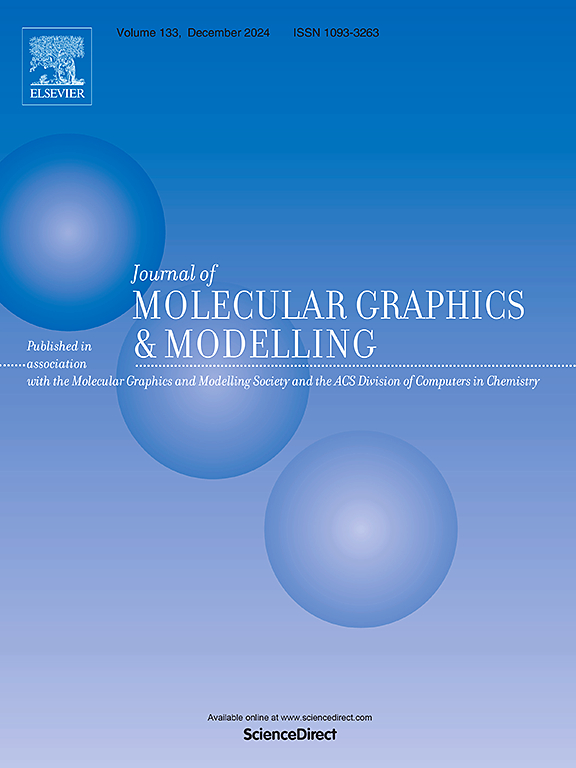基于网络药理学和计算分析的芦荟抗菌机制探讨
IF 3
4区 生物学
Q2 BIOCHEMICAL RESEARCH METHODS
引用次数: 0
摘要
细菌耐药性已成为全球面临的一项重大临床挑战。天然产品,如芦荟,由于其多种活性成分,提供了有希望的抗菌潜力。然而,明确的分子机制尚不清楚。本研究采用网络药理学、分子对接、分子动力学模拟等多学科方法探讨芦荟的抗菌机制。我们利用多源生物信息学平台筛选芦荟的8种主要活性成分及其靶点,鉴定出55个与芦荟抗菌作用密切相关的靶点。蛋白-蛋白相互作用网络分析揭示了潜在的关键靶点,包括半胱氨酸-天冬氨酸蛋白酶-3 (CASP3)和基质金属蛋白酶-9 (MMP-9)。基因本体功能富集分析表明,这些靶点在“对外源刺激的反应”、“基因表达的正向调控”和“胶原分解代谢”等重要的生物过程中发挥着关键作用。京都基因与基因组百科信号通路分析表明,这些靶点主要参与与癌症、脂质代谢、动脉粥样硬化和糖尿病AGE/RAGE信号通路相关的通路。这一发现提示芦荟可能通过调节宿主的免疫反应和代谢来发挥其抗菌作用。分子对接和分子动力学模拟表明,芦荟的活性成分槲皮素、芦荟大黄素等能够与CASP3、MMP-9形成稳定的配合物,对靶标的活性位点具有很强的结合亲和力。进一步的抗菌活性测定和反转录定量聚合酶链反应(RT-qPCR)分析表明,芦荟大黄素对革兰氏阳性菌具有抗菌作用,并抑制MMP-9基因的表达。本研究揭示了芦荟的抗菌机制,并强调了MMP-9是一个关键靶点。这些发现为进一步研究天然抗菌药物奠定了基础。本文章由计算机程序翻译,如有差异,请以英文原文为准。

Probing the antibacterial mechanism of Aloe vera based on network pharmacology and computational analysis
Bacterial resistance has emerged as a major clinical challenge globally. Natural products, such as Aloe vera, offer promising antimicrobial potential due to their diverse active components. However, the explicit molecular mechanisms remain unknown. In this study, we employed a multidisciplinary approach integrating network pharmacology, molecular docking, and molecular dynamics simulation to explore the antibacterial mechanism of Aloe vera. We screened the eight major active components of Aloe vera and their targets using multi-source bioinformatics platforms, identifying 55 targets closely associated with the antibacterial effects of Aloe vera. Protein-protein interaction network analysis, revealed potential crucial targets, including cysteine-aspartic acid protease-3 (CASP3) and matrix metalloproteinase-9 (MMP-9). Gene ontology functional enrichment analysis revealed that these targets play critical roles in several essential biological processes, such as “response to xenobiotic stimulus”, “positive regulation of gene expression”, and “collagen catabolism”. The Kyoto Encyclopedia of Genes and Genomes signal pathway analysis indicated that these targets are primarily involved in pathways associated with cancer, lipid metabolism, atherosclerosis, and the AGE/RAGE signaling pathway in diabetes. This finding suggests that Aloe vera may exert its antibacterial effects by regulating the host's immune response and metabolism. Molecular docking and molecular dynamics simulations demonstrated that active ingredients of Aloe vera, such as quercetin and aloe-emodin, can form stable complexes with CASP3 and MMP-9, exhibiting vigorous binding affinity to the active sites of the target. Further antibacterial activity assays and reverse transcription quantitative polymerase chain reaction (RT-qPCR) analysis demonstrated that aloe-emodin exerts antibacterial effects against gram-positive bacteria and inhibits the expression of the MMP-9 gene. This study provided insight into the antibacterial mechanisms of Aloe vera, highlighting MMP-9 as a key target. These findings lay a foundation for further studies on natural antibacterial agents.
求助全文
通过发布文献求助,成功后即可免费获取论文全文。
去求助
来源期刊

Journal of molecular graphics & modelling
生物-计算机:跨学科应用
CiteScore
5.50
自引率
6.90%
发文量
216
审稿时长
35 days
期刊介绍:
The Journal of Molecular Graphics and Modelling is devoted to the publication of papers on the uses of computers in theoretical investigations of molecular structure, function, interaction, and design. The scope of the journal includes all aspects of molecular modeling and computational chemistry, including, for instance, the study of molecular shape and properties, molecular simulations, protein and polymer engineering, drug design, materials design, structure-activity and structure-property relationships, database mining, and compound library design.
As a primary research journal, JMGM seeks to bring new knowledge to the attention of our readers. As such, submissions to the journal need to not only report results, but must draw conclusions and explore implications of the work presented. Authors are strongly encouraged to bear this in mind when preparing manuscripts. Routine applications of standard modelling approaches, providing only very limited new scientific insight, will not meet our criteria for publication. Reproducibility of reported calculations is an important issue. Wherever possible, we urge authors to enhance their papers with Supplementary Data, for example, in QSAR studies machine-readable versions of molecular datasets or in the development of new force-field parameters versions of the topology and force field parameter files. Routine applications of existing methods that do not lead to genuinely new insight will not be considered.
 求助内容:
求助内容: 应助结果提醒方式:
应助结果提醒方式:


